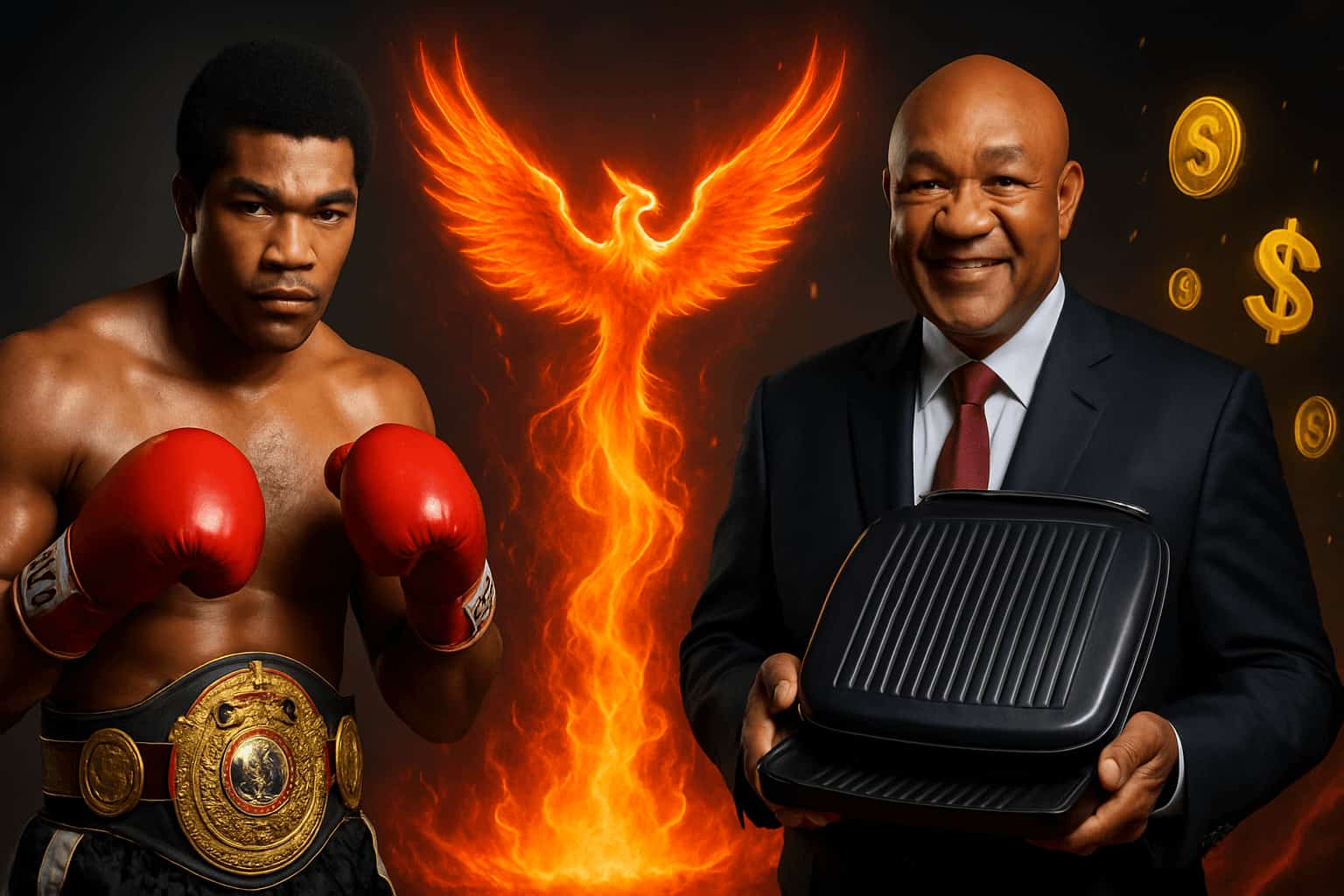Table of contents
- From the Bloody Fifth Ward to Olympic Glory
- A Turning Point: From the Streets to the Ring
- The Destroyer: Boxing Dominance and Championship Glory
- The Fall: Rumble in the Jungle and the Loss of Everything
- Ministry, Bankruptcy, and Rock Bottom Again
- The Impossible Return: Boxing Comeback at 38
- Round by Round: A Comeback No One Expected
- The Oldest Champion in History
- The Grill That Made George Foreman Richer Than Boxing Ever Did
- A Deal That Changed Everything
- From Modest Sales to Multimillionaire
- The Ultimate Proof That Success Isn’t About Luck
- Legacy of Character and Transformation
- Why George Foreman’s Story Matters Today
- Listen to the Complete George Foreman Story
How the legendary boxer lost everything, then built a $300 million fortune to prove his greatness was no accident
When most people think of George Foreman, they picture either the intimidating heavyweight champion who terrorized opponents in the 1970s, or the smiling grandfather figure selling grills on late-night television. But the real George Foreman story is far more extraordinary than either of these images suggests. It’s the story of a man who went from the streets of Houston’s most dangerous neighborhood to Olympic gold, then to heavyweight champion of the world, then to bankruptcy, and finally to building an even greater fortune than he’d ever achieved in boxing.
George Foreman’s journey is the ultimate proof that success isn’t about luck, timing, or being in the right place at the right time. It’s about character, resilience, and the unbreakable belief that no matter how far you fall, you have the power to rise again. This is why George Foreman represents the perfect example of what we call “The Phoenix Ascent” – the rare ability to lose everything and build it back even bigger.
From the Bloody Fifth Ward to Olympic Glory
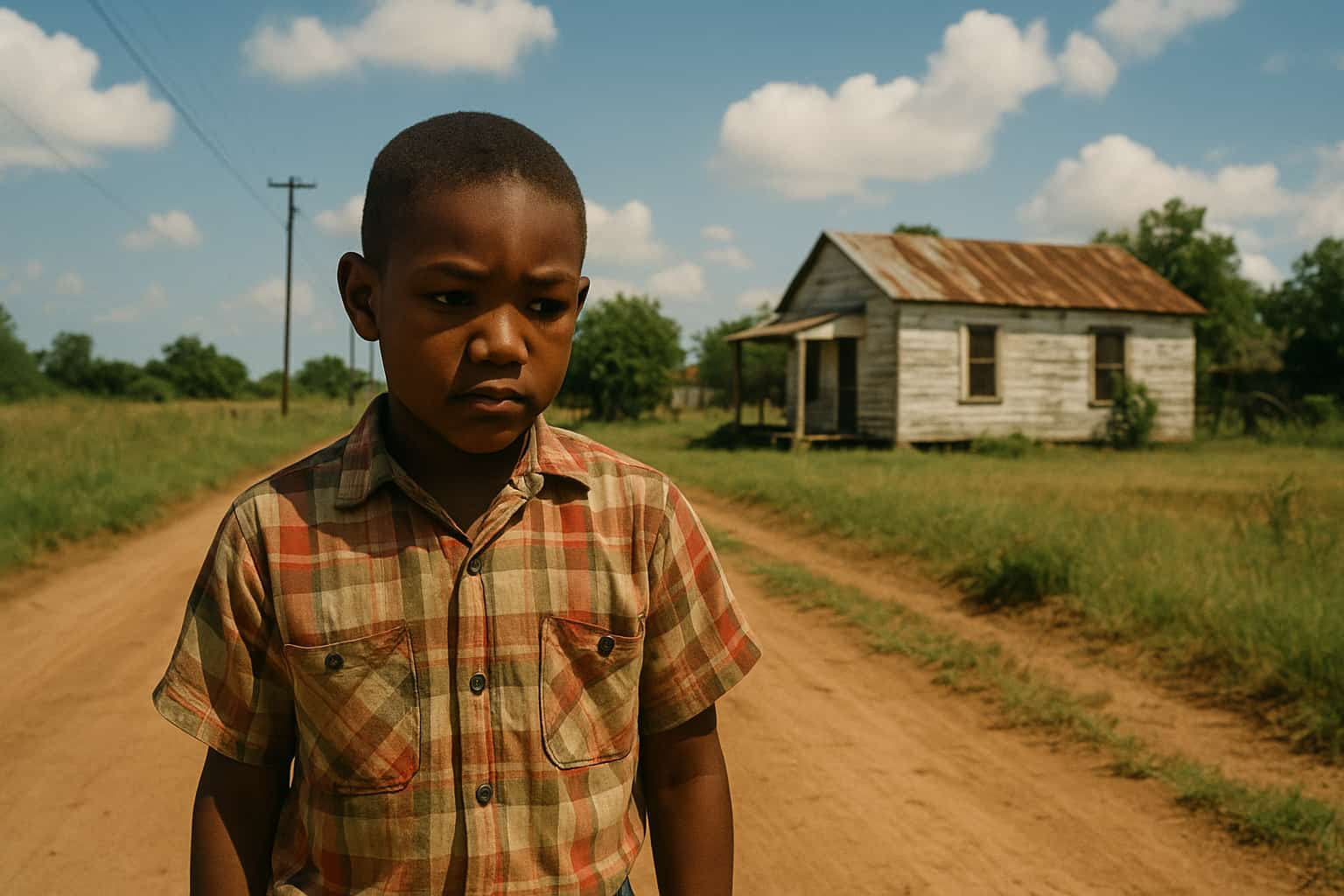
George Foreman was born on January 10, 1949, in Marshall, Texas, but raised in Houston’s Fifth Ward, a neighborhood so violent it earned the nickname “The Bloody Fifth.” This wasn’t just poverty – this was a place where survival meant being tougher than the next kid, where dreams were luxuries most families couldn’t afford, and where young men like George Foreman seemed destined for lives of crime and desperation.
By age 15, George Foreman was a high school dropout, washing dishes at the same restaurant where his mother worked as a cook. But the real money, he discovered, wasn’t in the dish pit. It was on the streets after dark, where he could use his imposing size to take what he needed from others. George Foreman became a street fighter and thief, caught in a vicious cycle of stealing money to buy alcohol, drinking to find courage to steal again.
A Turning Point: From the Streets to the Ring
The turning point came when George Foreman woke up one morning wearing nothing but his underwear, with no memory of how he’d gotten there. Next to him was a pamphlet titled “I Am an Alcoholic.” This was rock bottom, but it was also the moment that would change everything. Because at that exact time in American history, President Lyndon B. Johnson was launching the “War on Poverty,” and one of its weapons was the Job Corps program.
George Foreman entered the Job Corps at 16, traveling first to Oregon, then to California. It was in Pleasanton where he met Doc Broadus, a boxing trainer who saw something special in this angry, towering teenager. Under Broadus’s guidance, George Foreman discovered he possessed devastating natural power and an intimidating presence that made opponents nervous before the first bell rang.
After just 20 amateur fights, George Foreman was selected for the 1968 U.S. Olympic team. At the Mexico City Olympics, he demolished his competition, going the distance only once in four bouts. But it was his gold medal celebration that created one of the most iconic moments in Olympic history – George Foreman dancing around the ring while waving a small American flag, a spontaneous expression of gratitude for a country that had given him a second chance.
The Destroyer: Boxing Dominance and Championship Glory
When George Foreman turned professional in 1969, he entered a heavyweight division filled with legends like Muhammad Ali, Joe Frazier, and Ken Norton. But from his very first fight, it was clear that something different had arrived. George Foreman didn’t just beat opponents – he destroyed them.
By 1972, George Foreman had compiled a perfect record of 37-0 with 35 knockouts. From 1971 through 1974, he never fought longer than four rounds without scoring a knockout. Promoters called him “The Destroyer,” and the nickname fit perfectly. George Foreman’s fighting style was pure efficiency – no wasted motion, just devastating power delivered with mechanical precision.
The boxing world took notice when George Foreman earned the right to challenge Joe Frazier for the heavyweight championship in 1973. Frazier was undefeated, had never been knocked down, and seemed to get stronger as fights progressed. Most experts expected a long, brutal war.
Instead, George Foreman delivered one of the most shocking performances in boxing history. He knocked Frazier down three times in the first round and finished him in the second. The victory wasn’t just a changing of the guard – it was a statement that George Foreman was operating on a different level than every other heavyweight in the world.
George Foreman’s next defense against Ken Norton was even more convincing. Norton had broken Muhammad Ali’s jaw and proven his credentials, but George Foreman knocked him out in the second round, leaving Norton unconscious on the canvas. Two fights, two former champions, two devastating knockouts. George Foreman wasn’t just the heavyweight champion – he was the most feared fighter on the planet.
The Fall: Rumble in the Jungle and the Loss of Everything

The money was incredible, more than George Foreman had ever imagined possible. His purses reached hundreds of thousands of dollars, endorsement deals poured in, and for someone who had grown up washing dishes for pennies, this level of financial success was almost overwhelming. George Foreman was living the American dream, proof that hard work and determination could overcome any circumstances.
October 30, 1974. Kinshasa, Zaire. The Rumble in the Jungle. These words still send chills down boxing fans’ spines because what happened that night changed not just the heavyweight division, but George Foreman’s entire life trajectory.
George Foreman entered the fight as the overwhelming favorite against Muhammad Ali, who many believed was past his prime. The betting odds heavily favored George Foreman, and for good reason – he had destroyed the same fighters who had given Ali tremendous difficulty.
But Ali had been studying George Foreman for months, developing a strategy that would later be called one of the most brilliant tactical performances in boxing history. The “rope-a-dope” strategy involved letting George Foreman punch himself out against Ali’s defense, then taking over when the younger fighter’s power diminished.
For seven rounds, the strategy seemed to backfire as George Foreman landed heavy shots. But something strange was happening – for the first time in his career, George Foreman was getting tired. He had never needed to pace himself before because his fights always ended quickly.
Ministry, Bankruptcy, and Rock Bottom Again
In the eighth round, Ali came off the ropes with renewed energy, and then it happened. A perfectly timed right hand caught George Foreman flush on the chin, and for the first time in his professional career, he hit the canvas. The most feared heavyweight in the world was lying on his back, staring up at the lights while the referee counted him out.
The loss to Ali was more than just a defeat – it was a complete destruction of George Foreman’s identity. He had built his entire sense of self around being unbeatable, and suddenly he was just another former champion. The boxing world’s reaction was swift and brutal, questioning whether George Foreman had ever been as good as his record suggested.
George Foreman continued fighting after the Ali loss, but something fundamental had changed. The aura of invincibility was gone, and with it went much of what had made him special. In 1977, after a difficult fight against Jimmy Young, George Foreman experienced what he described as a religious awakening and decided to retire from boxing to become a preacher.
George Foreman founded the Church of the Lord Jesus Christ in Houston and opened the George Foreman Youth Center, designed to keep kids away from the drugs, gangs, and violence that had nearly destroyed his own life. He threw himself into ministry with the same intensity he had brought to boxing, determined to give back to his community.
But there was a problem: running a church and youth center was expensive. George Foreman was pouring his boxing earnings into these projects at an unsustainable rate. By 1983, the unthinkable had happened – George Foreman, the former heavyweight champion who had earned millions in the ring, was facing bankruptcy.
The Impossible Return: Boxing Comeback at 38
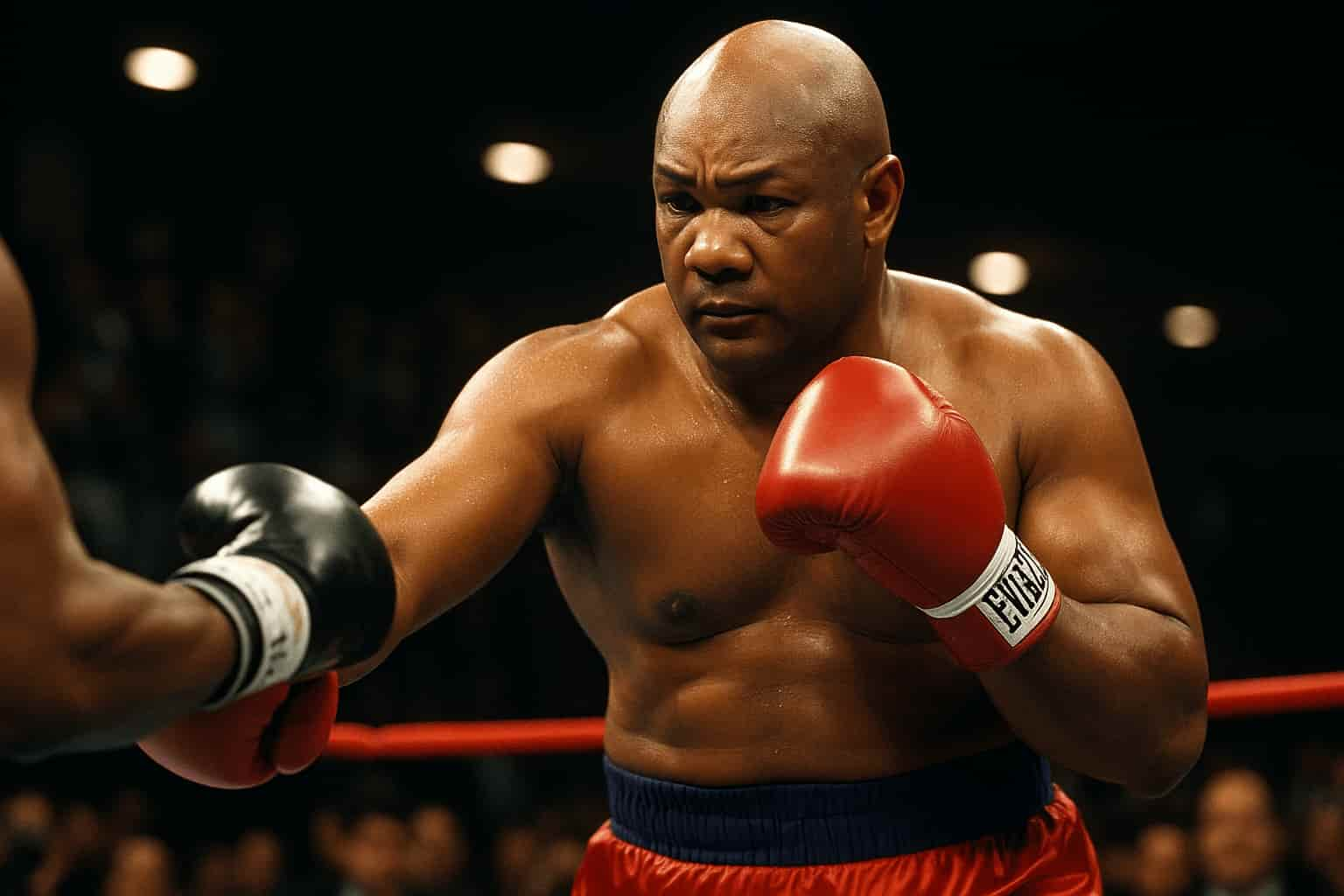
George Foreman was 38 years old, had been retired for ten years, and was facing financial ruin. The youth center was struggling to stay open, and bills were mounting faster than his dwindling savings could cover them. For most people, this would have been the end of the story.
But George Foreman was not most people. As he looked at the stack of unpaid bills and the faces of young people who depended on his programs, George Foreman made a decision that shocked everyone: he was going back to boxing.
The announcement was met with everything from disbelief to ridicule. George Foreman, at 38, after ten years away from the sport, wanted to return and eventually challenge for the world title. Boxing experts called it delusional, sports commentators called it dangerous, and his own family called it crazy.
But George Foreman had done the math. He needed money to keep the youth center open, and boxing was the only way he knew to make that kind of money quickly. More importantly, George Foreman believed he still had something left in the tank, something that ten years of preaching hadn’t diminished.
Round by Round: A Comeback No One Expected
The early fights of George Foreman’s comeback were painful to watch. He was slow, out of shape, and clearly rusty. Opponents who wouldn’t have lasted a round with the 1970s version were now giving him competitive fights. Media coverage was largely negative, treating his comeback as a sideshow rather than serious athletic endeavor.
But something interesting was happening as George Foreman continued to fight. He was getting better. The reflexes were returning, timing was improving, and most importantly, the power was still there. George Foreman’s punches still carried the kind of force that could end fights instantly.
George Foreman was also discovering something he hadn’t known during his first career: he was actually enjoying boxing in a way he never had before. During his championship years, boxing had been about anger and intimidation. Now, it was about proving to himself that he could overcome any obstacle, that age and circumstances couldn’t define what he was capable of achieving.
The boxing world began taking notice as George Foreman’s comeback gained momentum. He was winning fights, looking more like his old self with each performance, and surprisingly, becoming a fan favorite in a way he had never been during his first career. The angry, intimidating champion of the 1970s had been replaced by a smiling, grandfatherly figure who seemed to be having the time of his life.
The Oldest Champion in History
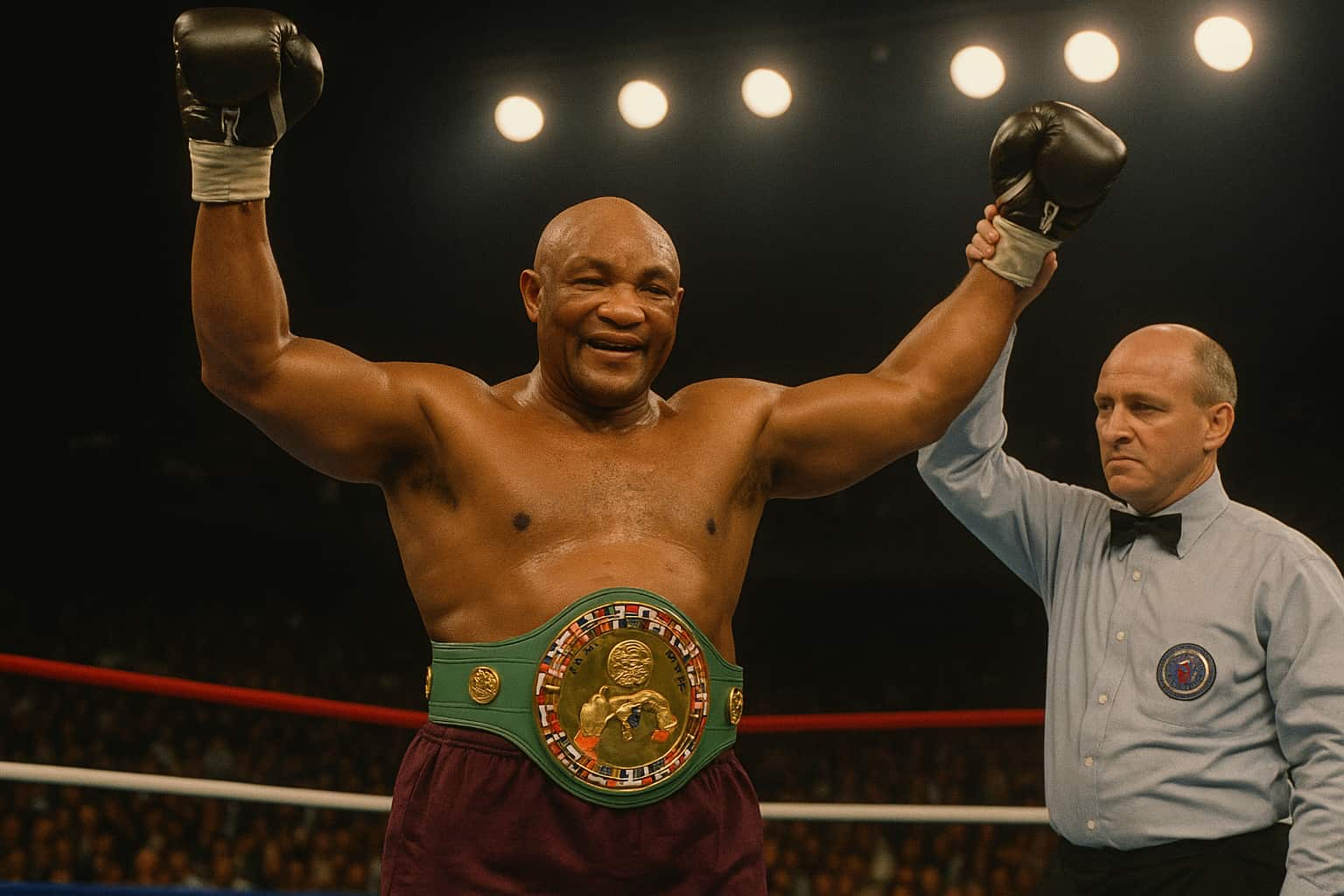
By the early 1990s, George Foreman had worked his way back into contention for the heavyweight title. The division had changed dramatically during his absence, but George Foreman adapted, adjusting his style to account for his age and changed circumstances.
The culmination came on November 5, 1994, in Las Vegas, when George Foreman faced Michael Moorer for the WBA and IBF heavyweight titles. At 45 years old, George Foreman was by far the oldest man ever to challenge for the heavyweight championship. Moorer was 26, in his prime, and heavily favored.
For nine rounds, it looked like the experts were right. Moorer was outboxing George Foreman, moving well, landing clean shots, and building a commanding lead. George Foreman looked every bit his 45 years, slow and ponderous, seemingly unable to catch his younger opponent.
But in the tenth round, magic happened. George Foreman landed a short right hand that caught Moorer flush on the chin, and suddenly the 26-year-old champion was lying unconscious on the canvas. The crowd erupted in disbelief as George Foreman, at 45, became the oldest heavyweight champion in boxing history.
The victory was more than just a boxing triumph – it was vindication of everything George Foreman had believed about himself and the power of determination. He had proven that his original success hadn’t been a fluke, that his championship credentials were real, and that with enough heart and determination, it was possible to overcome any obstacle.
The Grill That Made George Foreman Richer Than Boxing Ever Did
The boxing comeback was remarkable, but it was only the beginning of George Foreman’s second act. While proving that age was just a number in the ring, Foreman was about to discover that his greatest financial success wouldn’t come from his fists—it would come from a kitchen appliance.
In 1994, the same year he became the oldest heavyweight champion, Foreman received a call that changed his life. Salton Inc., later known as Russell Hobbs, had created a new electric grill. It was a compact indoor appliance that cooked meat quickly while draining away fat.
George Foreman wasn’t the company’s first choice. They had approached other celebrities before turning to him. But something about Foreman’s comeback—his transformation from fierce fighter to lovable grandfather—made him the perfect fit. He represented strength, change, and health, all of which the grill symbolized.
At first, Foreman was unsure. He was a boxer, not a chef. He was known for punches, not recipes. But as he learned more about the product, he saw its potential. It wasn’t just about cooking—it was about helping families prepare healthier meals easily.
A Deal That Changed Everything
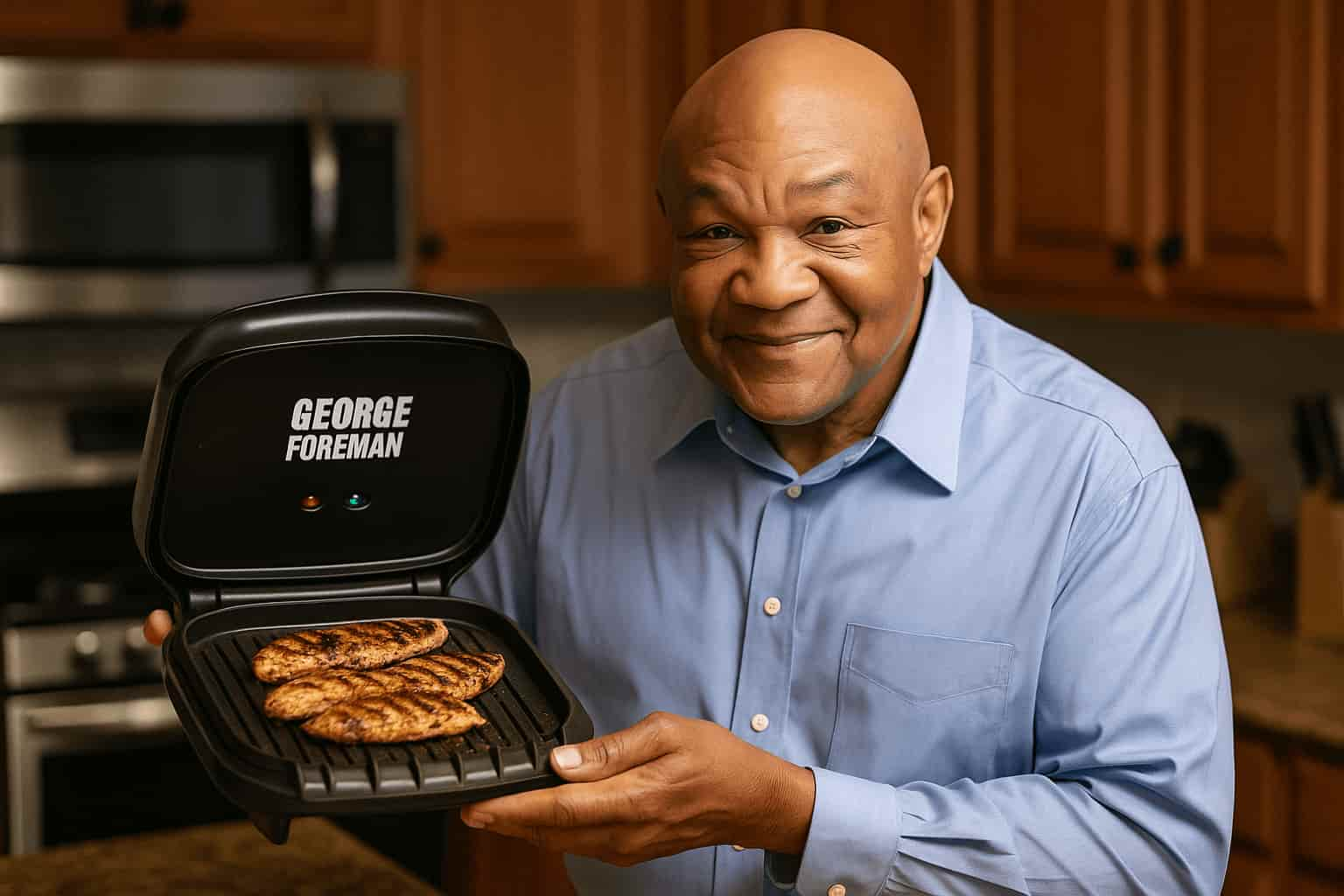
Having worked with young people for years, Foreman cared deeply about health and nutrition. This endorsement felt personal, not commercial. It was a chance to make a real impact in homes across America.
Foreman agreed to become the spokesperson, but on his terms. Instead of taking a flat fee, he negotiated a share of every grill sold. It was a gamble. If the product failed, he’d make almost nothing. But if it succeeded, the rewards would be massive.
The grill launched in 1994. At first, sales were modest. But Foreman’s genuine enthusiasm and credibility began to resonate with consumers. His face and voice brought trust to the product.
The commercials were unforgettable. A former heavyweight champion talking passionately about healthy meals—it was unexpected, memorable, and effective. Foreman wasn’t faking it. He used the grill himself. He believed in it. That authenticity made all the difference.
From Modest Sales to Multimillionaire
Sales began climbing fast. Each month, Foreman’s royalty checks grew. What had started as a modest endorsement was quickly becoming a financial powerhouse. By the late 1990s, he was earning millions annually from the grill alone.
The George Foreman Grill wasn’t just successful—it changed how people thought about indoor cooking. It made healthy eating convenient. It became a staple in kitchens across the world. More than 100 million units were eventually sold, making it one of the most successful consumer products in history.
In 1999, Foreman reached a financial milestone. Salton offered to buy the rights to his name and likeness for the grill. They paid $137.5 million for that deal. It was more than Foreman had earned in his entire boxing career.
He accepted the offer, securing his financial future forever. The man who had once declared bankruptcy was now worth hundreds of millions. And it all came from a simple, health-focused kitchen tool.
The Ultimate Proof That Success Isn’t About Luck
The irony wasn’t lost on George Foreman. He spent his first career hurting people, using his fists to cause pain in the ring. Now, in his second career, George Foreman helped people live healthier lives and encouraged families to eat better. He promoted wellness instead of fear or intimidation, making it easier to cook nutritious meals at home.
Critics once questioned if George Foreman’s early boxing success was luck or timing, not true skill or merit. The grill’s massive success proved otherwise—it showed George’s success came from more than boxing skill. His success wasn’t limited to the ring—it came from who he was: driven, relatable, and unafraid to take risks.
Legacy of Character and Transformation

Hard work, people skills, confidence, and persistence weren’t just boxing traits—they were life skills he applied across industries. And those same traits made George Foreman successful not once, but twice, in completely different careers.
Today, George Foreman’s net worth is over $300 million. He has twelve children, a thriving ministry, and a youth center. That youth center still serves his community today, proving his legacy goes far beyond the boxing ring. The impressive numbers don’t tell the full story of what George Foreman truly accomplished.
The real story is transformation—not just George’s, but the example his life sets for all of us. George Foreman’s life shows failure can lay the foundation for future greatness. Low points can launch our highest achievements.
When George Foreman lay on the canvas in Zaire in 1974, knocked out by Ali, he felt broken. He couldn’t imagine that defeat would lead to a greater legacy than anything he’d done as an undefeated champion. Losing to Ali forced him to face limits, reflect, and discover untapped strength and inner character.
Bankruptcy in 1983 became another turning point in George Foreman’s story. It could have ended his ambition. He didn’t get bitter or give up. Instead, he used that hardship to find new meaning and direction. He saw it as motivation—to rebuild, to prove himself, and to help others rise too.
Why George Foreman’s Story Matters Today
George Foreman’s story disproves the myth that success depends only on luck, timing, or being in the right place. He succeeded multiple times in completely different arenas, under completely different conditions. He won as a young boxer, an older comeback champion, a businessman, and a beloved cultural figure. The constant through every success wasn’t luck—it was character. He worked hard, learned from failure, rejected limits, and turned losses into future motivation. He cared deeply about others and wanted his legacy to make a real, lasting difference.Success, to him, wasn’t just personal—it was about service to others.
Foreman’s story proves the power of second and third chances—and that it’s never too late to reinvent yourself. When he was a teen washing dishes in Houston, nobody predicted he’d become an Olympic champion. He was knocked out by Ali, yet nobody imagined he’d regain the title 20 years later. After bankruptcy, few expected George Foreman to become one of the wealthiest athletes in history. But George Foreman understood something most don’t: your past doesn’t define your future. Failure isn’t final—unless you let it be. The only true limits in life are the ones we accept for ourselves.
The youth center Foreman founded still helps Houston teens facing the same challenges he faced growing up. His programs have helped thousands avoid gangs, drugs, and find positive paths through discipline, mentorship, and opportunity. In many ways, this may be George Foreman’s greatest achievement – not the championships or the money, but the lives he has changed and the hope he has provided to young people who needed someone to believe in them.
Listen to the Complete George Foreman Story
George Foreman’s incredible journey from the streets of Houston’s Fifth Ward to Olympic gold, to heavyweight champion, to bankruptcy, to champion again, to business mogul worth $300 million, represents the ultimate phoenix ascent. His story proves true champions are defined by character, determination, and refusing to believe their best days are behind them
This remarkable story of resilience, reinvention, and ultimate triumph is exactly why we created The Phoenix Ascent podcast. George Foreman’s story isn’t just entertainment—it’s a guide for anyone who’s failed and wants to come back stronger.
In our deep-dive episode, you’ll discover:
- The shocking details of George Foreman’s childhood in Houston’s most dangerous neighborhood
- How the Job Corps program literally saved his life and launched his boxing career
- The inside story of his devastating knockouts of Joe Frazier and Ken Norton
- What really happened during the famous “Rumble in the Jungle” with Muhammad Ali
- The financial decisions that led to George Foreman’s bankruptcy in 1983
- How he engineered one of the greatest comebacks in sports history
- The surprising phone call that led to the George Foreman Grill empire
- Why George Foreman earned more from kitchen appliances than from boxing
- The life lessons that prove success is never about luck
George Foreman proved that the phoenix doesn’t rise in spite of the ashes – it rises because of them. His story will change how you think about failure, success, and what’s truly possible when you refuse to stay down.
Subscribe to The Phoenix Ascent podcast and discover more incredible stories of entrepreneurs who lost everything and built it back even bigger, proving once again that success is never about luck – it’s about the courage to rise again.

